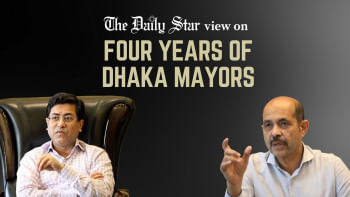DNCC can’t even spend its tree-planting budget!

No Dhaka dweller—not even the two city mayors whose vision of the capital often differs drastically from that of its residents—can deny the urgency of enhancing green covers in a city that has fast been reduced to a concrete jungle. Yet, a recent report by this daily reveals that the Dhaka North City Corporation (DNCC) has failed tragically to utilise the funds allocated for tree plantation over the past eight years. Of the Tk 20.50 crore allocated to expand greenery, the DNCC's environment wing could spend only Tk 8.64 crore—43 percent of the total allocation. During the current mayor's tenure, the DNCC allocated Tk 14 crore for tree plantation, but could only use Tk 5.25 crore. Such a lacklustre attempt on their part to replenish the lost greenery of Dhaka is shameful, to say the least.
Over the past decades, trees have been struck down with unparalleled zeal to make way for buildings, commercial spaces, and highways. Dhaka has turned into a heat island, which experiences much higher temperatures than outlying areas as a result of ruthless urbanisation. Studies show a drastic decline in Dhaka North's green cover, which dropped from 47 percent in 1992 to a meagre 16 percent in 2022. We are frustrated to note that the passion with which trees are felled are not matched by a passion to replace them.
The DNCC authorities would have us believe that their failure lies in the absence of plantable land in its jurisdiction. While it is true that barren land areas for planting trees in Dhaka North have dropped from around 11 sq-km in 2012 to 2.2 sq-km in 2022, it only highlights the urgency for the city corporation to devise new and innovative ways to expand the green coverage. The DNCC must conduct a thorough assessment of plantable spaces and revise its tree plantation strategies to ensure effective budget utilisation. It needs to explore innovative solutions like vertical forests with vegetation on buildings, green roofs and walls, pocket parks for green havens in dense areas, and urban forests for recreation and carbon capture. It can incorporate nature-based solutions into urban infrastructure, including bioswales (planted channels that filter stormwater), rain gardens (depressions that collect and slowly release rainwater), and green street corridors lined with trees.
We agree wholeheartedly with DNCC Mayor Atiqul Islam that there is no point of spending money for spending's sake. However, we cannot accept that the DNCC has exhausted all innovative options for enhancing green cover in its jurisdiction. There is certainly much it can learn and replicate from other global cities that have turned themselves into green oases from industrial hubs; what it needs is political will and vision to use unutilised budgets on creative and sustainable solutions.


 For all latest news, follow The Daily Star's Google News channel.
For all latest news, follow The Daily Star's Google News channel. 










Comments